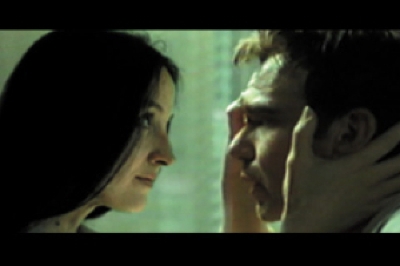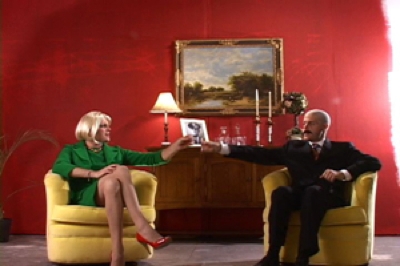Feature: Reviews
Conversation 4: Jillian Mcdonald & Mark Lee Morris
- San Francisco Arts Commission Gallery
- June 29 — August 25, 2007
In Conversation 4, the San Francisco Arts Commission Gallery has created an interaction between New York artist Jillian Mcdonald and San Francisco-based artist Mark Lee Morris, creating a dialogue on identity in a media-saturated culture.
Jillian Mcdonald explores the pain and obsession involved in being a fan. In her series titled Me and Billy Bob, she focuses on actor Billy Bob Thornton. While this particular concept may seem contrived, her multidisciplinary works come together to provide an empathic and touching meditation on frustrated love and loneliness. Her work is both painfully sincere and self-critical, and therefore avoids the dangers of easy irony or derision of fan culture.
Mcdonald’s works span several mediums and years. She uses photography, video, installation, and performance/social practice work to ultimately create a self-portrait rather than a depiction of Thornton. By documenting both her own and other fans’ identification with this notorious celebrity, she creates a sociological study that is heartbreakingly familiar. Billy Bob Thornton doesn’t really matter; he is a stand in for any person or ideal, ever-changing, that will never sincerely reciprocate our own desires or feelings.
Mcdonald’s first artwork of this project is a powerful video titled Me and Billy Bob. This short piece features Thornton in a variety of on-screen roles, with Mcdonald digitally inserting herself into the tableau as his romantic partner. The soundtrack is a duet of Thornton with another woman, and the ever-changing scenes provide no narrative or dialogue. Meaning is created in artificial glances and kisses. Mcdonald inserts herself skillfully into these films, but she still appears out of place. The borders of her body are fuzzy, and her proportions seem slightly askew in comparison to Thornton. Nevertheless, this imperfect film has a subtle beauty, which transcends celebrity idolization or simple camera tricks.
Mcdonald’s work also portrays a fair amount of both physical and emotional pain. Her process is a lonely enterprise; she is the only actor and producer. She is also the instigator of her own persecution, routinely inflicting violence upon herself. In the video Drum Solo for Billy Bob (Billy Bob’s 49th Birthday), the camera focuses on Mcdonald’s hands. She repeatedly strikes her palm with Thornton’s drumstick in a syncopated version of one of his songs. While not an obviously brutal act, the sheer repetition of this minor act evokes the masochistic, repeated pining for someone completely unavailable. Music is omitted, creating a stark contrast to the romanticized version of idolization in Me and Billy Bob. Several other pieces involve a similar ritualized abuse. In Billy Bob Tattoo, Mcdonald traces and retraces a gothic-lettered “Billy Bob” on her knees for an entire month, several times per day. Like Drum Solo for Billy Bob, Mcdonald enacts a repeated torture that builds in severity over time.
In this body of work, Mcdonald’s fixation on Thornton becomes a vehicle both for her own abuse and self-scrutiny. It is no coincidence that she bases this project on a figure known for his rebellious and unstable character. In an installation of fan letters sent to Mcdonald, she visually highlights excerpts that fetishize Thornton’s troubled persona: e.g. one note prominently reads, “I love Billy Bob because he’s such a bad ass”. In the video Screen Kiss, Mcdonald moves forward from Thornton’s unrequited love by inserting herself into encounters with a host of new brooding actors, such as unconventional heartthrob Vincent Gallo. Although this video is similar to Me and Billy Bob, it differs in a subtle but important way. In each scene and with each new actor, Mcdonald recognizes her audience. She winks and smiles at either the viewer or Thornton, seeming to recognize both the humor and pathos in her involved fantasies.
Similarly to Mcdonald, Mark Lee Morris uses the tropes of Hollywood to explore the boundaries of the self. In Hamartia, Morris creates a melodramatic soap opera where he plays screenwriter, director, videographer, and all of the actors. Like Me and Billy Bob, Morris is the sole participant in these involved episodes.
In Hamartia, the melodrama centers on Buddy Morris, the comatose owner of a soap company. Morris uses more camp and melodrama than Mcdonald; he seems to deliberately overact as Morris’s mother, lover, and doctor. Morris’s work also differs from McDonald’s project in its artificiality. While Mcdonald’s videos approach a seamless integration of her body into the scenes, Morris’s episodes leave the construction and artificiality in clear view. Morris acts in front of an audience: he creates these episodes in front of the public at the SFAC Gallery Grove Street Windows. I imagine that the performance looks very strange, as Morris recites over-dramatic lines to open space. He grafts the different segments together to create an artificial scene, but the borders between each shot are clearly visible. Shot at different times of day and with imperfect timing, each segment has different lighting, and the characters occasionally talk over one another. At times, one character will lean out of his individual frame, or the interaction between two characters will be physically disjointed.
Hamartia may seem like an exercise in narcissism; Morris succeeds in creating a jarringly insulated environment. However, Morris enacts a universal desire: to enact many possibilities and situations, and also to become one’s own entourage. By becoming entirely self-sufficient, Morris creates a meaningful environment in the absence of any other people. At the same time, Hamartia counteracts this possibility by revealing its own construction.
When Hamartia and Me and Billy Bob are presented in conjunction, the two derive a shared meaning. Conversation 4 illustrates popular media’s function as a stage for our own desires: Viewers project their own fantasies upon the characters of film and television, allowing for both self-indulgence and punishment. Conversation 4 is also significant in its presentation of Bay Area artists within a global context. By exhibiting artists from two coasts side by side, SFAC Gallery engages both artists (and viewers) in a dialogue that transcends their own individual projects and geography.



